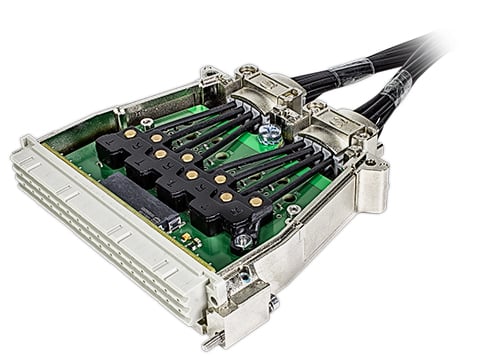The small solution for big power
Electric motors of various performance classes are just as much a part of modern society as smartphones, the internet and electrical railway transportation. Motors are used with performances ranging from a few watts all the way up to megawatts. The control technology for these motors is quite simple as long as they run at a constant speed or have low power consumption. In such cases, a conventional control strategy is sufficient. However, things get more complicated when the motors require regulated speed or have a high power consumption.
They are able to switch a large load using a very low level of control power. Due to their high insulation and voltage requirements, the signals for controlling the IGBTs are transmitted using plastic optical fibers (POF).
In the AOC, individual fibers are bundled into a robust DIN housing which also houses the transceivers for converting the optical signals into electrical signals. This housing meets the stricter requirements for railway and industry that define robustness and EMC compatibility. The cables can be guided straight or angled because there is an optimal built-in bend protection and strain relief mechanism for the fibers.
Using a 16-connection board as an example, the AOC will use 40% less space and you will only need to connect one plug to ensure a secure connection. The optical fibers are not opened here and cannot be mixed up. In the event that a cable is defective, the DIN housing can be opened and the defective cable can be replaced individually. If a connection for an optical fiber is defective, you can simply swap the cheap cable assembly. It is no longer necessary to carry out a complex replacement of the entire expensive module. In contrast to the old solution, the optical connections on the AOC's board can be reflow soldered so they can be connected using an automated workflow. That convincingly provides added value for the customer.
HARTING's solution is smaller, more robust, safer to use and much faster and cheaper to service. Overall, the customer receives a solution that is not only more reliable, but also significantly cheaper over its entire service life. We bring movement into the future: with HARTING's Active-Optic cabling.
Your benefits at a glance:
- The one-time plug-in connection saves time during servicing
- Electrical plugging – Optical transmission
- Optimal bend protection and strain relief
- Space savings of 40% compared to the previous solution
The previous termination technique for the optical fibers took up quite a lot of space and was not very easy to service. For a three-phase motor, a redundant design required six connections just for the control. If even one of them failed, the entire control module had to be replaced. To carry this out, each fiber had to be disconnected and reconnected individually. The risk of damage and incorrect fiber connections are quite high in this scenario. HARTING now demonstrates how the POF transmission link can be redesigned in a much more compact and modular way. The priorities here are easier installation, quicker servicing procedures, and the use of Active Optical Cables (AOC) which make optical plug-in connections superfluous. The advantages provided by "electrical plugging and optical transmission" can be best leveraged in industrial environments.


